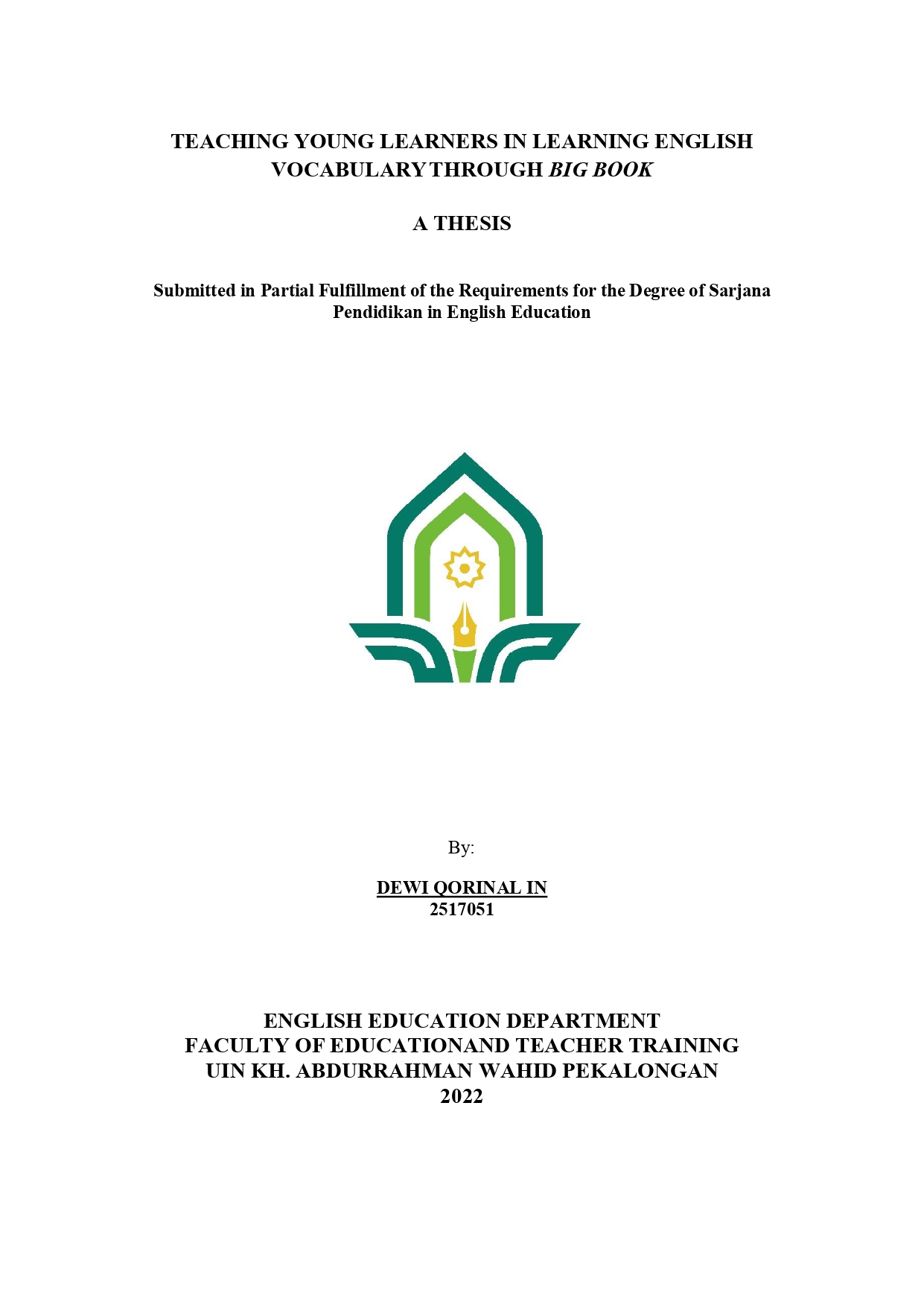
SKRIPSI TADRIS BAHASA INGGRIS
Teaching Young Learners in Learning English Vocabulary Through Big Book
In English as a foreign language (EFL), learning vocabulary plays a vital role in all language aspects (listening, speaking, reading, and writing). Reading becomes very important for young learners because they could get a number of new vocabularies. The teacher needs to have a certain strategy to make the reading experience more enjoyable for young learners. The characteristics of Big Book, which has big-sized colorful pictures and big font enhance young learners’ reading experience. This narrative inquiry research aims to examine the use and the challenges in the Big Book to engage young learners in learning English vocabulary. In collecting the data, the researcher uses observation and semi-structured interview. The participants are five young learners aged between 6 to 9 years old. The result shows that the big-sized colorful picture and the big size of Big Book itself engaged student behaviorally, emotionally, also cognitive. The challenges shown in the learning process are the silent student and the difficulties of pronouncing the word.
Keywords: Big Book, Young Learners, Vocabulary
Ali, M. M., & Hassan, N. (2018). Defining Concepts of Student Engagement and Factors Contributing to Their Engagement in Schools. Creative Education, 9, 2161-2170. https://doi.org/10.4236/ce.2018.914157
Amy, S.C. Left & Gazda, R., (1999). The Visual World of Young Learners: Case Studies, Journal of Visual Literacy, 19(1), 53-64, DOI: 10.1080/23796529.1999.11674544
Ana, I. K. T. A. (2018). Teaching English Vocabulary for Young Learners through Electronic Guessing Game. Journal of Psycology and Instruction, 2(1), 22-30.
Alqahtani, M., (2015). The Importance of Vocabulary in Language Learning and How to be Taught. International Journal of Teaching and Education, 3(3) 21-34. DOI: 10.20472/TE.2015.3.3.002
Aulia, M., Adnan., Yamin, M., & Kurniawati, M., (2019). Penggunaan Big Book Dalam Pembelajaran Membaca Permulaan Di Sekolah Dasar. Jurnal Basicedu, 3(3), 963-966.
Celik, B. (2020). A Study on the Factors Affecting Reading and Reading Habits of Preschool Children. International Journal of Linguistic, 10(1) 101-114. DOI:10.5539/ijel.v10n1p101
Jang, H., Deci, E, L,. & Reeve, J., (2010). Enggaging Students in Learning Activities: It Is Not Autonomy Support or Structure but Autonomy Support and Structure. Journal of Educational Psychology, 102(3), 588-600.
Larsen-Freeman, Diane., & Anderson, Marti., (2011). Techniques and Principles in language Teaching. New York: Oxford.
Lelawati, S., Dhiya, S., & Mailani, P. N., (2018). The Teaching Of English Vocabulary To Young Learners. Professional Journal of English Education, 1(2), 95-100. DOI: 10.1037/a0019682
Mandel, D. (1967). Changing art changing man. New York: Horizon Press.
Nalantha, I. M. D., Artini, L. P., & Mahayanti, N. W. S., (2018). The Effect of Big Books as Teaching Media on The Third Grade Students’ Reading Comprehension In South Bali. International Journal of Language and Literature, 2(2), 72-81.
Nation, I. S. P. (2001). Learning vocabulary in another language. Cambridge: Cambridge University Press.
Nurani, R. Z. & Mahendra, H. H. (2019). Use of Big Book Learning Media to Improve Students’ Beginning Reading Skills in Primary Schools. Mimbar Sekolah Dasar, 6(3), 330-340. DOI: 10.17509/mimbar-sd.v6i3.22893.
Puspitasari, D. (2016). ‘Mommy, Let‘S Read The Books‘: Engaging Young Learner In Reading Aloud Activity.__English Language Teaching and Translation,
Sesmiyanti,. (2016). Student’s Cognitive Engagement in Learning Process. Journal Polingua, 5(2), 48-51.
Ketersediaan
| 23SK2325023.00 | SK TI 23.023 DEW t | My Library (Lantai 3. Local Content) | Tersedia |
Informasi Detail
- Judul Seri
-
-
- No. Panggil
-
SK TI 23.023 DEW t
- Penerbit
- Pekalongan : Jurusan S-1 Tadris Bahasa Inggris FTIK UIN K.H. Abdurrahman Wahid Pekalongan., 2022
- Deskripsi Fisik
-
43 hlm., 30 cm; Bibliografi: 44-47
- Bahasa
-
Inggris
- ISBN/ISSN
-
-
- Klasifikasi
-
371. 33
- Tipe Isi
-
-
- Tipe Media
-
-
- Tipe Pembawa
-
-
- Edisi
-
-
- Subjek
- Info Detail Spesifik
-
-
- Pernyataan Tanggungjawab
-
Dewi Qorinal In (2517051)
Versi lain/terkait
Tidak tersedia versi lain
Lampiran Berkas
Komentar
Anda harus login sebelum memberikan komentar
 Karya Umum
Karya Umum  Filsafat
Filsafat  Agama
Agama  Ilmu-ilmu Sosial
Ilmu-ilmu Sosial  Bahasa
Bahasa  Ilmu-ilmu Murni
Ilmu-ilmu Murni  Ilmu-ilmu Terapan
Ilmu-ilmu Terapan  Kesenian, Hiburan, dan Olahraga
Kesenian, Hiburan, dan Olahraga  Kesusastraan
Kesusastraan  Geografi dan Sejarah
Geografi dan Sejarah